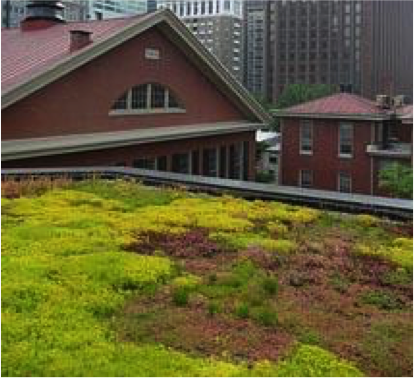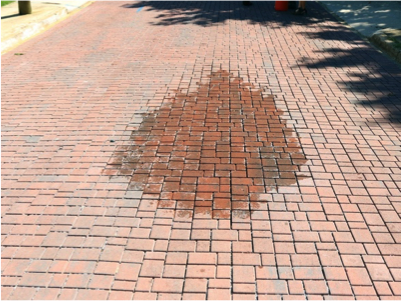Stormwater and the pollution it spreads is becoming a major issue, especially in cities where it is the most difficult to control runoff. The greater amount of impermeable surface in cities prevents rainwater and snowmelt from penetrating the surface. Instead, the rainwater and snowmelt becomes runoff along our streets. Managing stormwater, and the pollution it carries, is a crucial part of protecting both residents and the infrastructure of a city. Green infrastructure is one way that cities can achieve this goal.
Gray Infrastructure
Traditional stormwater infrastructure, called gray infrastructure, includes pipes, storm drains, and water treatment systems. While gray infrastructure does reduce the water in cities during precipitation events, it simply relocates the water elsewhere. Storm drains and gutters typically relocate water into surface waters, including lakes, rivers, and wetlands. According to the EPA, this “stormwater runoff carries trash, bacteria, heavy metals, and other pollutants from the urban landscape.” The EPA also notes, “higher flows resulting from heavy rains also can cause erosion and flooding in urban streams, damaging habitat, property, and infrastructure.” These negative environmental effects are a major downside to many current stormwater management systems.
Green Infrastructure
While gray infrastructure is a necessary part of managing stormwater, green infrastructure is another, more environmentally friendly way to manage stormwater. Green infrastructure attempts to mimic undeveloped areas where rainwater is allowed to permeate the ground close to the place it lands, allowing it to be naturally filtered by the soil and vegetation. The EPA states, “Green infrastructure uses vegetation, soils, and other elements and practices to restore some of the natural processes required to manage water and create healthier urban environments… provid[ing] habitat, flood protection, cleaner air, and cleaner water.” The EPA lists and defines multiple types of green infrastructure here. The types of green infrastructure listed include downspout disconnection, rainwater harvesting, rain gardens, planter boxes, bioswales, permeable pavements, green streets and alleys, green parking, green roofs, urban tree canopy, and land conservation. Some pictures of green infrastructure are below.

Source: EPA at https://www.epa.gov/green-infrastructure/what-green-infrastructure

Source: EPA at https://www.epa.gov/green-infrastructure/what-green-infrastructure
Benefits of Green Infrastructure
The pollution reduction in both cities and bodies of water that previously received water runoff is a major benefit of green infrastructure. My home city of Atlanta is an example of a city that took steps to implement large scale green infrastructure when it stated the Southeast Atlanta Green Infrastructure Initiative in 2012. As of November, 2015, Atlanta had the largest permeable pavement project in the U.S. More information in a news report on Atlanta’s project can be found here. The pictures below are from some of the streets where Atlanta installed permeable pavement.
In addition, the creation of environmental, green areas full of plants add to the beautification of cities. Even initiatives that do not include the addition of plants, such as permeable pavements and downspout disconnections, prevent standing water on streets and around buildings. According to the American Society of Landscape Architects, “ALSA”, Green infrastructure can “provide less expensive, and more cost effective, approaches to managing runoff.” The ALSA continues by stating, “Municipalities and developers may benefit from lower capital costs, land acquisition requirements, operational expenses and other financial burdens when green infrastructure is integrated into new construction, redevelopment projects, or programs to reduce combined and sanitary sewer overflows.” Furthermore, green infrastructure can reduce the expenditures on and extensiveness of gray infrastructure in a city. For example, according to American Rivers, Indianapolis reduced the diameter of a new sewer by 7 inches and saved over $300 million thanks to its green infrastructure. Green infrastructure can also reduce flooding when cities commit to restoring natural wetlands and channels, which can protect people and save money. For example, according to American Rivers, Napa, CA’s commitment to exactly this “has protected 2,700 homes and prevented $26 million in flood damage.” Lastly, a commitment to green infrastructure can help cities meet the compliance standards set forth in the EPA’s Clean Water Act. The benefits of green infrastructure to the environment, people, and cities are numerous and far-reaching. Ultimately green infrastructure makes the world we live in a better place and it is something many cities should consider implementing. For more information from the EFC on stormwater and financing stormwater initiatives look here.

Source: news.wabe.org/post/atlanta-home-largest-permeable-pavers-project-us

Source: news.wabe.org/post/atlanta-home-largest-permeable-pavers-project-us
What kinds of green infrastructure has your city implemented?
Michael F. Burgess is a law student in the class of 2018 at the Emory University School of Law. He currently serves as a legal intern for the Environmental Finance Center.
The contents of all posts authored by students are solely the responsibility of the authors. Statements made and opinions expressed are strictly those of the authors and not the Environmental Finance Center or The University of North Carolina at Chapel Hill.





Leave a Reply